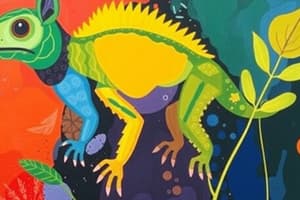Podcast
Questions and Answers
What adaptation helps aquatic plants to efficiently photosynthesize?
What adaptation helps aquatic plants to efficiently photosynthesize?
- Fully submerged roots
- Floating leaves
- Deep water anchoring
- Modified stems and roots (correct)
All plants in polar regions are able to grow as tall as trees.
All plants in polar regions are able to grow as tall as trees.
False (B)
What is the primary reason plants develop thorns and spines?
What is the primary reason plants develop thorns and spines?
To deter herbivory
A ______ is a place where a plant or animal lives.
A ______ is a place where a plant or animal lives.
Match the following plant adaptations with their purposes:
Match the following plant adaptations with their purposes:
Which of the following is NOT a type of aquatic habitat?
Which of the following is NOT a type of aquatic habitat?
Herbivory refers to the consumption of plant matter by organisms.
Herbivory refers to the consumption of plant matter by organisms.
Name one common plant species found in polar regions.
Name one common plant species found in polar regions.
Which of the following regions is known for its tropical rainforests?
Which of the following regions is known for its tropical rainforests?
Animals in polar regions adapt primarily through camouflage.
Animals in polar regions adapt primarily through camouflage.
What is the primary function of blubber in animals?
What is the primary function of blubber in animals?
Name one adaptation that helps Green-Eyed Tree frogs avoid predation.
Name one adaptation that helps Green-Eyed Tree frogs avoid predation.
All plants need the same conditions to survive.
All plants need the same conditions to survive.
What is the life cycle duration of annuals or drought evaders?
What is the life cycle duration of annuals or drought evaders?
Name one adaptation that allows cacti to survive in the desert.
Name one adaptation that allows cacti to survive in the desert.
Succulents store water in their roots, stems, or leaves.
Succulents store water in their roots, stems, or leaves.
What type of germination occurs when seeds germinate while still attached to the plant?
What type of germination occurs when seeds germinate while still attached to the plant?
The __________ insect mimics twigs or dried-up stalks to avoid predators.
The __________ insect mimics twigs or dried-up stalks to avoid predators.
Some plants in the desert have _____ roots that can absorb water from deep in the ground.
Some plants in the desert have _____ roots that can absorb water from deep in the ground.
Name an example of a halophyte.
Name an example of a halophyte.
Match the following animal adaptations with their respective environments:
Match the following animal adaptations with their respective environments:
Mesophytes have a poorly developed root system compared to other plant types.
Mesophytes have a poorly developed root system compared to other plant types.
What is the primary chlorenchyma tissue found in Sonneratia?
What is the primary chlorenchyma tissue found in Sonneratia?
What environmental condition is a characteristic of polar regions?
What environmental condition is a characteristic of polar regions?
Match the following adaptations to the corresponding types of plants:
Match the following adaptations to the corresponding types of plants:
Halophytes grow in _______ habitats.
Halophytes grow in _______ habitats.
Blubber is a layer of fat found in some sea mammals to help insulate their bodies.
Blubber is a layer of fat found in some sea mammals to help insulate their bodies.
The roots in monocotyledones typically form a ________ system.
The roots in monocotyledones typically form a ________ system.
Match the plant types with their characteristics:
Match the plant types with their characteristics:
Which of the following is an adaptation of plants in tropical rainforests?
Which of the following is an adaptation of plants in tropical rainforests?
Match the following characteristics with the appropriate type of plant:
Match the following characteristics with the appropriate type of plant:
Which of the following adaptations is found in mangrove plants?
Which of the following adaptations is found in mangrove plants?
What is one animal that has dense fur as an adaptation in polar regions?
What is one animal that has dense fur as an adaptation in polar regions?
Succulents do not retain water to survive in dry environments.
Succulents do not retain water to survive in dry environments.
What happens to leaves of certain trees during autumn in tropical rainforests?
What happens to leaves of certain trees during autumn in tropical rainforests?
Drought avoiding plants complete their life cycle before summer.
Drought avoiding plants complete their life cycle before summer.
Which plant is an example of a succulent?
Which plant is an example of a succulent?
Flashcards are hidden until you start studying
Study Notes
Tropical Rainforests
- Located primarily in India, Brazil, and Central America, with the largest concentration in the Amazon River Basin.
- Camouflage is crucial for survival; the Green-Eyed Tree frog has textured skin that mimics tree bark, aiding in predation avoidance.
- Mimicry allows animals to imitate venomous species, reducing predation risk; the Margin-winged stick insect adeptly resembles twigs.
Adaptations in Polar Regions
- Polar regions, including the north and south poles, experience extreme cold with winter temperatures dropping as low as -37 °C.
- Long periods of daylight and darkness can last an entire six months, impacting the ecosystem.
- Dense fur in polar bears not only insulates but also helps with camouflage against the snowy backdrop.
- Blubber in seals and whales provides insulation and buoyancy, serving as an energy reserve during food scarcity.
Plant Adaptations
- Earth hosts around 300,000 plant species, each adapted to their habitats for survival based on light, water, soil, and nutrient availability.
Desert Plant Adaptations
- Succulents store water in modified stems and leaves, essential for survival in arid environments.
- Cacti have spines to minimize water loss, while deep roots help access underground water.
- Dormancy allows seeds to remain inactive until sufficient moisture is available for growth.
Tropical Rainforest Plant Adaptations
- Tall trees create competition for sunlight; ground-level plants often bloom in spring when sunlight is more accessible after autumn leaf drop.
- Some ground-level plants can photosynthesize effectively in low light conditions.
Aquatic Plant Adaptations
- Aquatic plants face challenges like low oxygen and light; many develop to float partially, optimizing for photosynthesis.
- Modified stems and roots help absorb nutrients and oxygen directly from water.
Polar Region Plant Adaptations
- Sparse vegetation includes sedges, dwarf shrubs, and mosses, typically under 12 inches tall.
- Short stature and hairy parts assist in insulation, while permafrost limits deep root penetration in larger plants.
Adaptations Against Herbivory
- Plants evolve thorns, spines, and chemical deterrents to protect against herbivore consumption.
- Chemicals can create unpleasant tastes or, in severe cases, be toxic to deter grazing.
Biome Definition and Classification
- Biomes combine climate, plants, and animals to create distinct habitats classified into terrestrial (land) and aquatic (water) categories.
- Terrestrial habitats include forests, grasslands, deserts, and mountains, while aquatic includes freshwater and marine ecosystems.
Types of Plant Adaptations
- Annuals/Drought Evaders: Live for a few weeks longer than rains, with small sizes and thick, waxy leaves.
- Succulents/Drought Resisting: Store water in roots, stems, or leaves; includes plants like cacti and aloe.
- Nonsucculents/Drought Enduring: True xerophytes that endure both external and internal dryness, e.g., Acacia.
- Drought Avoiding Plants: Complete life cycles before summer, utilizing brief wet periods.
Halophytes and Mangroves
- Halophytes thrive in saline environments; examples include Rhizophora and Avicennia found in marshy coastal areas.
- Features of mangrove plants include stilt roots for stability and pneumatophores for gas exchange above water.
- Viviparous germination in mangrove plants allows seedlings to stabilize in mud while remaining above water level.
Mesophytes
- Grow under average temperature and moisture conditions, positioned between hydrophytes and xerophytes.
- Develop robust root systems with well-formed tissues and structures optimized for water absorption and support.
Studying That Suits You
Use AI to generate personalized quizzes and flashcards to suit your learning preferences.




